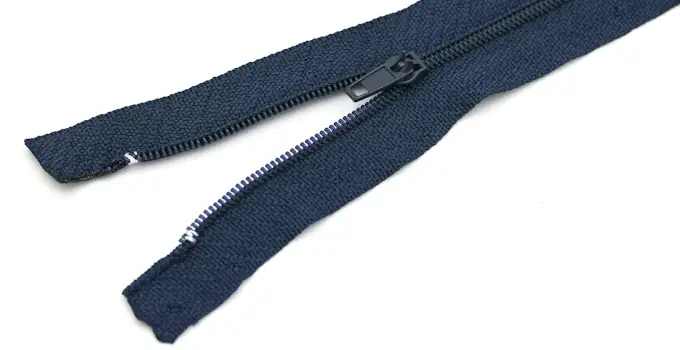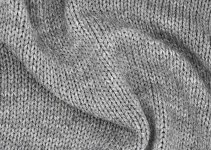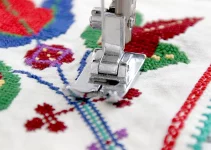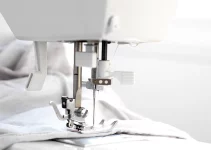I’m pretty sure that when most of us think of zipper alternatives, we think of snaps, velcro, buttons, hooks and eyes, etc. All these examples are also known as fasteners.
If we’re talking about zipper alternatives, we need to explore all types of fasteners that we can use when making clothes, bags, backpacks, leather goods and all sorts of other projects.
If you’re interested, check out my reviews for the best sewing chair, too.
Also, I wrote an article answering the question how many teeth does a zipper have. It can be an interesting thing to read if you want to know more about these popular fasteners.
The Most Popular Zipper Alternatives
1. Buttons: Wennuo 100Pcs Black Sewing Buttons
There are so many different types and designs of buttons to choose from. Buttons can be gorgeous so some people might prefer them over zippers in some cases because they’re simply beautiful and can make a garment stand out. Metal buttons can also be used as zipper alternatives for jeans.
2. Hook and loop (velcro): VELCRO Brand Sticky Back for Fabrics
The big thing zippers and velcro have in common is that they’re among the most hermetic fasteners. Velcro is also an amazing choice for those who want a fastener that is targeting effortless self-dressing. Hook and loop is the perfect zipper alternative because they’re also highly versatile.
3. Snaps: Samuay Snap Buttons for Sewing and Crafting
Snaps can be just as wonderful as buttons. If you don’t want to sew them by hand, just choose the non-sew snaps type that need a snap pliers for installation.
11 Zipper Alternatives: the Most Popular Fasteners

When I think of fasteners, I automatically think of buttons. For me, buttons and zippers remain two of the most popular fasteners and the two that can be found on most of my clothes, whether as pure decorations or as serving a practical purpose.
Whichever you end up choosing will depend on the fabric you’re working with, the pattern of the garment you’re making, what type of fastener you’re most comfortable working with, the effect you want to create (whether you want a hidden fastener or one that makes a bold statement), the position and type of opening, and the amount of stress the fastener will experience.
The type of fastener you end up choosing as a zipper replacement depends on you. You know what your patterns need and what will work best for your particular project. You’ll have to do a bit of thinking but I hope these zipper alternatives and in-depth introduction to different types of fasteners will help you to make your final decision.
I want to explore a wide array of replacements for zippers so that you can find the right one for your projects.
According to this paper from the New Mexico State University, the most common fasteners are snaps, self gripping devices, and hooks and eyes.
I will also add that buttons are certainly another very popular zipper substitutes and I think the reverse is also true.
The main zipper alternatives that I’ll cover in this article are:
- buttons
- toggles
- fabric loops
- snaps
- magnetic snaps
- snap tape
- eyelets
- grommets
- hooks and eyes
- hook and loop (velcro)
- buckles
Now, let’s say a few words about each of these zipper alternatives so that we know what type of garments they’re used for as fasteners.
1. Buttons
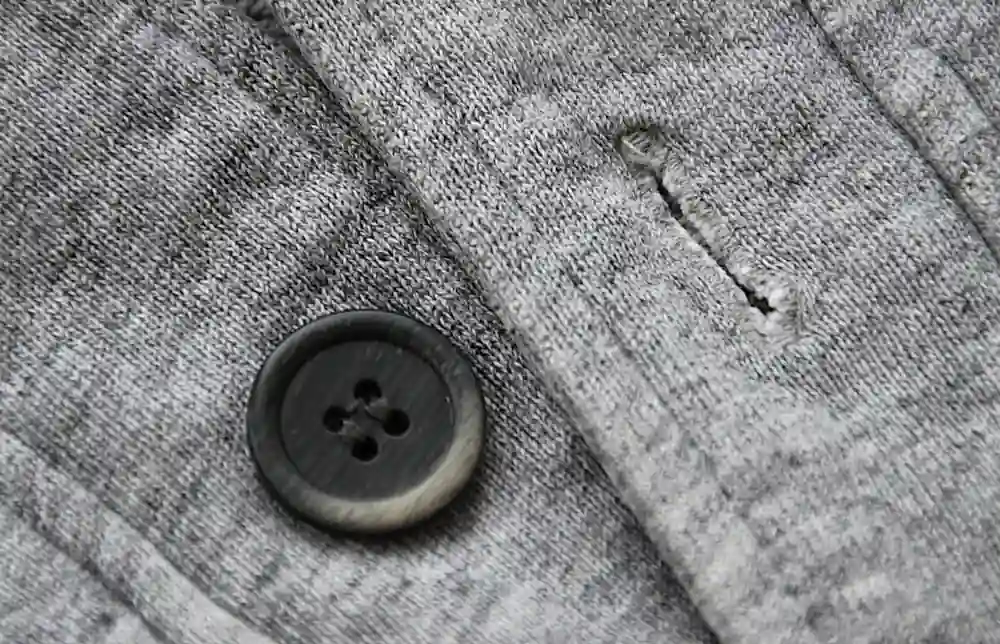
Let’s start by talking about my favorite fasteners. Zippers are practical, there are fewer situations when they’re decorative in our day to day lives. But buttons can certainly be both.
Buttons are the type of fasteners that can be used in two different ways: to blend with the fabric and the pattern or they can make a statement all on their own.
There’s practically an entire universe of buttons to choose from.
However, when it comes to using buttons as zipper alternatives, there’s the problem of making the buttonholes.
Making buttonholes can be just as important as the type of buttons you end up choosing for your project. Buttonholes are usually ⅓ inches larger than the button. Or ¼ inches for larger buttons.
We can use sewing machines for making buttonholes. These models come with a buttonhole foot as an accessory for this purpose. You can open up the machine-stitches buttonhole by using a straight pin and a sharp seam ripper.
There are also machines that include a button sew-on foot for sewing the buttons once you have the buttonholes ready.
These types of sewing machines usually include a zipper foot, as well. So you can use a machine for both types of fasteners.
The other alternative is to learn to sew buttonhole stitch by hand. Then you can sew the buttons by hand, as well.
Buttons size
When it comes to clothing, the most commonly used sizes are from 7/16 inches to 1 ⅛ inches (11 to 28mm). The larger ones are usually meant for coats, accessories, and outerwear.
Large buttons are also used to make a statement. These types can also be stitched to a fabric in a certain place just for attracting attention and for beautifying the look.
For example, large, statement buttons might be attached to a coat placket just for form and hidden fasteners, like snaps, could be added for closing the coat. Statement buttons are decorative, while the snaps actually serve the role of a fastener, hidden from view.
Material
Then, there’s the material the buttons are made from. You can pick from plastic, wood, leather, metal, natural & eco-friendly, fabric, glass & ceramic and clay.
Plastic buttons
Plastic ones come in all shapes and sizes.
They can also imitate other materials, like glass, faux wood, etc.
Usually, they’re cheap, easy to find, and come in different shapes, sizes, colors, and can imitate other materials. They are also washable and very durable.
Wood
This is another material that can look absolutely gorgeous.
Wood buttons can also have different shapes, colors, sizes, patterns, etc.
When it comes to washing, they can be more demanding. Most wooden buttons cannot be soaked in water, some might have to be covered with a little foil as protection from the water or you can take the garments to a dry cleaner.
Metal
Metal buttons are a fantastic way to make a statement with any garment, whether we’re talking about coats, jackets, pants, skirts, dresses, etc.
The metals most commonly used are zinc alloy, brass, aluminum, iron, stainless steel.
If you want to make a statement, metal buttons can be one of the best zipper alternatives.
Metal buttons can also be found on jeans as a replacement for zipper flies. However, when it comes to pants of all kinds, not only jeans, I definitely prefer zipper flies.
There’s a practical reason for preferring zipper flies: they’re stronger, less likely to separate from the jeans, they can be hidden, and they can offer better support at the waist level.
Eco-friendly materials
In terms of natural and eco-friendly, we have shell and pearl, made from clams, mussels, river shells, and abalone.
Other materials used are natural and recycled materials, like bamboo, recycled resin, sea glass, corozo nut, etc.
Last but not least, glass buttons can be some of the most beautiful fasteners for our garments. If you’re looking for the wow factor, start with buttons made of glass. You’ll get lost in their beauty, especially the vintage ones.
Button type
Last but not least, we have button types to choose from.
Based on button types, we can choose from:
- flat (2 holes, 4 holes or multi-holes)
- shank
- statement
Shank buttons are the ones that have no holes on the surfaces. Instead, they come with a protrusion in the back that usually features a single loop or tunnel through which the needle and thread pass.
Statement buttons are usually the big, decorative ones.
2. Toggles
Since we’re talking about buttons let’s also quickly cover toggles as zipper alternatives because they actually belong to the buttons category.
These are small bars of wood, horn, metal, plastic resin that are used mainly on coats or outerwear.
Toggles are elongated buttons. They create a nice effect.
There are two types of toggles: those that have 2 large centered holes for attachment or those that have a loop/tunnel on the back (shank).
Toggles are usually fastened through a cord loop that is sewn on the opposite side of the garment.
3. Fabric loops
Now that we’ve mentioned toggles, it’s only fair that we should mention fabric loops as fasteners. These shouldn’t be confused with hook and loop (velcro).
Obviously, you can’t use fabric loops on their own. These will have to be attached to toggles, shank, ball, knot (Chinese ball) or pearl buttons.
There are different types of fabric loops that we can use as fasteners: made from thread, rouleau or spaghetti straps, ribbons, braids, covered cording, etc.
In the category of fabric loops we can also include frog closure.
A frog fastener is a braided loop fastening. This frog fastener can complement a Chinese ball. The cord can be fashioned on either side of the garment opening in an intricate braided loop that ends up looking like a frog. It’s very beautiful. A very pretty, decorative fastener that looks gorgeous on dresses, shirts made in an Asian style.
4. Snaps
Snaps can be almost as interesting as buttons when it comes to picking the best zipper alternatives.
One interesting aspect about snaps is that they would be greatly preferred as fasteners by those with dexterity issues.
There are two main types of snaps, based on how they’re attached to projects:
- two-piece snaps – these can be sewn by hand
- multi-piece non-sew snaps – they have pronged rings or a back plate and are clamped or hammered together, thus the name non-sew, you’ll need snap pliers for this type
Multi-piece non-sew snaps are also known as snap-in snaps because they require a snap pliers for installation.
Another thing you should know about snaps is that they can be both practical and decorative. It’s another thing they have in common with buttons and they’re both very popular fasteners.
Just like zippers, snaps can be made from metal or plastic.
Snap-in snaps have four components:
- socket – round, with a small hole in the center, the component that attaches to the snap cap
- snap cap – this is the decorative part, they come in many varieties, can be made from metal or plastic and, although most have the round classical shape, you can also find them in different shapes and sizes, especially if you’re looking for decorative options
- stud – also known as the ball, the socket and the stud interlock to form a strong and easy-to-use closure, it’s attached using the open prong
- open prong – is used to attach the socket, the pronged ring is the innermost part of the snap and has a smooth surface
5. Magnetic snaps
I will mention this type of fastener separately because these are mostly used on bags and purses.
Zippers can also be added on bags and purses, with the magnetic snap as the decorative fastener, while the zipper provides the security.
But if you’re not comfortable with attaching zippers on bags and you’re not concerned by the enhanced security that zippers offer, then you can just resort to attaching magnetic snaps.
6. Snap tape
It is also known as gripper tape.
This is the fastener used on baby clothes for easy diaper changes.
The snaps, which are made from plastic or metal, are already attached to the tape, which is then sewn to baby clothes.
The ends of the snap tape are hidden in the hem.
Snap tape is also available for outdoor uses and covers.
7. Eyelets
The first thing you should know about eyelets as zipper alternatives is that you need a special device, called an eyelet plier.
Once you have that figured out, I would say that eyelets are pretty easy to install. The eyelet plier clamps down on the eyelet, which makes the eyelet grip the fabric. It certainly sounds really easy.
However, before clamping down the eyelet on the fabric, you need to make a small hole through which to insert the eyelet. You can create these small holes with an awl. The eyelet is clamped down on the diameter of this hole you created. You should also treat each hole with a seam sealant.
The next thing you should know is that eyelets are small metal tubes with a lip. The metals used for making them can be aluminum, steel or brass. They can also be made from plastic or rubber.
They look like small colorful circles, if you choose to get the colorful ones.
These are the holes that you’ll find on shoes, through which a shoelace is threaded.
But we can also insert eyelets on our garments and then use a cord, lace or string to lace them. You can use a mix of colors for the metal eyelets and obtain a very nice design.
8. Grommets
We can’t really talk about eyelets without automatically mentioning grommets. Some people might even think that they’re the same thing. At first glance, I’m not even sure that we can tell them apart.
Grommets look very similar to eyelets. The main difference is that grommets are used for more heavy-duty materials. That means that they are usually bigger than eyelets and they’re stronger.
If you’re not making a dress or a light coat, you’ll probably end up looking at grommets as zipper alternatives.
Grommets are also used for heavy curtains or drapes.
If you’re buying a grommet kit, it will include everything you need for installing them.
9. Hooks and eyes
Hooks and eyes can be very nice zipper alternatives but they won’t be as hermetic.
This type of fasteners is usually applied on the inside of a garment.
Hooks and eyes can also be used as an addition to zippers, like above the zipper on dresses, skirts, and tops.
Thus, hooks and eyes can work well on their own but, when combined with zippers, they provide an extra closure that ensures that the zipper remains secure.
Hooks and eyes are predominantly used for bra making and other lingerie garments.
The traditional hook and eye is a small fastener made from metal wire. It has 2 parts: one is the hook on one side and on the other side is a C-shaped piece (the eye).
All in all, there are a variety of them: standard, larger in size for coats, decorative brooch styles, hook and bar (used as a fastener for waistbands).
10. Hook and loop (velcro)
Out of all fasteners, zippers and velcro are the most hermetic. They can create a complete seal so they have a variety of uses in all kinds of industries. Zippers are more widely used.
Hook and loop (velcro) is a fastener made of polyester and nylon.
It has two sides: a rigid hook side and a softer loop side.
The two sides are aligned and pressed together in order to form a secure bond.
We’ll usually find the hook and loop fastener on shoes, baseball caps, pockets, jackets, ski apparel, costumes, doll clothes, pillows, bed skirts, etc.
Velcro is also used for making clothes that are intended for effortless self-dressing, like children and senior clothes.
Hook and loop options are varied: strips, rolls, and dots (coins).
11. Buckles
We all know about the classic buckles that are inserted into the holes on our trousers. But buckles can also serve as fasteners, especially if you’re looking for something to make a statement.
The most common example where buckles are used as fasteners is jumpers. These are also known as suspender buckles or overall buckles. This type can also be used for bib overalls, coats, wool pants, suspenders, as backpack decorations, etc.
Another category is the bridal sash buckles. Their purpose is mostly decorative and they’re beautiful.
Other types are:
- side release buckles (sporting goods, backpacks, luggage, pet accessories)
- interlocking (fashion, sporting goods, outdoor gear)
- leather tab buckle
- swivel (a clip-on style usually found on bags, clutches, totes)
Main Types of Zippers for our Garments
Zippers are some of the simplest and most efficient fasteners, regardless of the garment we’re making. They’re also very easy to use, no matter what garment we’re making.
Moreover, I will admit that in some cases I couldn’t see any zipper alternatives that will work as well. For my pants, I’ll always use zipper flies. That is just one example.
Plus, even zippers can serve both a decorative and practical purpose, like it’s the case with buttons.
If you’re looking for decorative options, you should search for vintage zippers that can be found in antique and secondhand stores. The decorative elements will be featured on the tape or come in the form of an interestingly shaped pull.
These are many types of zippers to choose from:
- nylon coil/polyester – the easiest to find and some of the most popular because they’re durable and flexible and are sold in a variety of colors and lengths to match any project
- metal – used on denim garments, they’re not flexible so they’re not the best for projects that require stretch but they’re some of the most durable, given that they’re made from aluminum, brass or nickel and they can also be seen as decorative in the right projects
- invisible – these are invisible on the outside of the garment, which makes them highly used in the making of dresses, the teeth are nylon coil and are featured on the back side of the zipper, they can be shortened to any length by stitching over the teeth at the bottom to create a stop
- parka – as the name suggests, these are incredibly durable, they’re weatherproof and so they’re used for camping gear, nautical gear, sportswear
- pocket – these are used for all kinds of pockets, their usual size is 5 inches
- separating – these have no bottom stopper, instead they have a pin on one side and a box on the other at the bottom, they’re used in jackets, vests, coats, hoodies, etc.
- two-slider purse – if you’re making your own bags, you might want to consider this type
- lace – these can create a beautiful effect, especially on more delicate garments
Now that you know all about zippers and we’ve also covered some of the most important and frequently used zipper alternatives, you’ll definitely be able to quickly decide which fasteners are the best for your projects.

